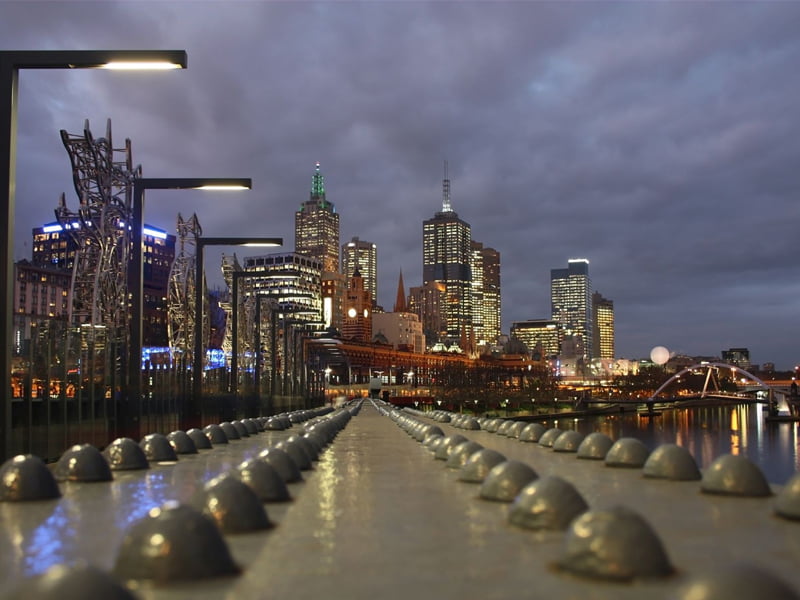Travelling in air-tight pods at 1,000 kilometres per hour is something most would imagine happening only in sci-fi films.
But with Hyperloop – an Elon Musk-led vision to develop a high-speed transportation system that could deliver people from Sydney to Melbourne in 55 minutes – this fictional idea has a growing sense of reality.
And for RMIT aerospace engineering alumni Zachary McClelland, that’s an exciting future.

Hyperloop works by using evacuated tube technology, which essentially means all air is “evacuated” from the tube, a capsule transports people or cargo, levitated with magnetics and accelerated to the speed of sound with linear motors. The technology expected to be able to travel up to 1000km/h.
Mr McClelland is one of the co-founders of VicHyper, the only team in the southern hemisphere selected to participate in the SpaceX Hyperloop competition out of 1,700 initial entries.
While the company didn’t win in the final round – where it unveiled the VicHyper pod in January – it was awarded the ‘Braking Subsystem Technical Excellence Award’.
Winning or not, Mr McClelland sees participating in Hyperloop not only as an opportunity to help revolutionise the way people travel, but also the possibility to revive the Australian manufacturing industry, which will take a hit when Holden closes its doors for the final time next month.
“I want to keep stuff in Australia. It’s my passion to help Australian people, and that’s where I want to stay,” Mr McClelland said.
“We need to get more manufacturing here; we just lost our car manufacturing. Why not go into another mode of transport that could revolutionise.”
This is part of the long-term back-up plan Mr McClelland has for a company that started off with a team of seven and has now grown to more than 30.
While the focus will still be Hyperloop, Mr McClelland said VicHyper will develop technology that can be used in a variety of industries in order to bring in revenue, making the company financially self-sustaining.
Until now, VicHyper has relied on sponsorship funding from investors such as construction giant John Holland and funding from the Victorian government.
“We don’t always want to be asking for money,” Mr McClelland said. “We want to be able to develop technology that’s versatile that it can be used for any industry.”
“But we are always going to have that key goal of getting Hyperloop off the ground because what it promises to deliver in transport travel is just amazing.”
Recruiting for skills outside of RMIT will be another change the VicHyper team wants to make. Currently the team is made of only RMIT alumni and students.
“There is a lot of interest across the country wanting to join us. Once we get a bit more of an idea, we’ve had a bit of a change in direction in the last few months and have been on idle because it has just been so hectic in the last two years,” he said.
”We thought we should have a proper think about it and we know where we’re going to go now, so we’re going to get outside people from outside RMIT involved. But we will always be an RMIT team though.’
It’s also perhaps one way to plug Australia’s talent hole, which he says, is happening too frequently.
“There is a lot of talent out there but the problem is all of our skills are getting kicked overseas. The big industry for this stuff is Europe and America, and Australia is not up to scratch on that side of it. That’s why some of this startup is quite exciting,” Mr McClelland said.
“But we can always have more. It’s a big priority to keep students involved in STEM and what is out there. One of the big one for me is making sure regional students have the same access to all the awesome stuff the cities are doing.
“It doesn’t happen so much at the moment. I read a newspaper article the other day about how it’s so hard for regional students to go to university compared to a city student.”
While there are plenty of changes ahead, one thing he plans to keep the same is to avoid involving himself too much in the startup community.
“I haven’t really got into the startup community. I’m always just doing my own things. I don’t learn too much about their troubles because we’ve had exceptional luck with support due to the exciting thing we’re working on and the big aspiration we’re pushing for.”
For now VicHyper will continue to work on designing a simulation for Hyperloop that will clearly show the benefits of using the technology if people were to travel between Melbourne and Brisbane via Sydney compared to other existing transport modes.
“It will definitely change the way people move around. You can move so many people per hour, and we’re looking here going if we up the speed by so much, how much more travel is going to happen between these centres,” Mr McClelland said.
Do you know more? Contact James Riley via Email.

